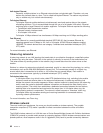
Chapter 9. Networking concepts
If you would like more information on networking topics, review the following:
v Advanced Peer-to-Peer Networking support
v Advanced Program-to-Program Communications
v Dependent LU Requester Support (DLUR)
v High-performance routing (HPR)
v Internet packet exchange support
v Systems Network Architecture
v TCP/IP
Advanced Peer-to-Peer Networking
Advanced Peer-to-Peer Networking (APPN) is one type of data communications support that is provided
by the AS/400 system. This support routes data in a network between two or more advanced
program-to-program systems. The systems do not need to be directly connected in the same network or
adjacent networks.
The APPC/APPN support handles all of the SNA protocol requirements when your system is
communicating with a remote system that uses the LU session type 6.2 and node type 2.1 architectures.
The remote system can be any of the following systems:
v AS/400 system
v System/36
v System/38
v IBM personal computer
v Displaywriter
v Series/1
v 5520 Administrative System
v RISC System/600 (Reduced Instruction Set Computer)
v DPPX/370 (Distribute Processing Programming Executive
v One of the following host systems:
– System/370
– System/390
– 30XX processor
– 43XX processor
– 9370 system
– Another system that supports the appropriate level of architecture
The AS/400 APPN support is an enhancement to the SNA Node Type 2.1 architecture that supplies
networking functions. These enhancements are easy-to-use, are dynamic; and give control of the network
to the peer systems that make up the network. APPN provides you with the following advanced functions:
v Distributed directory services
v Dynamic route selection that is based on user-specified values
v Intermediate session routing
v Routing of data by using transmission priorities.
With the exception of intermediate session routing, HPR builds on and uses these APPN functions. For
more information on HPR, see high-performance routing.
© Copyright IBM Corp. 1998, 2001 87


















